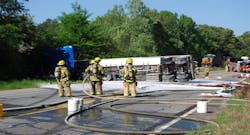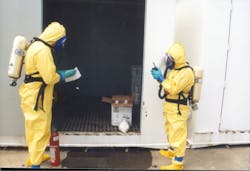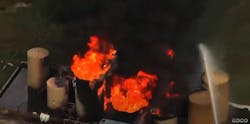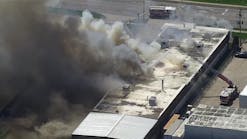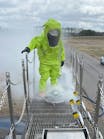The application of the principles and theories of the science of chemistry to answer specific questions or solve real-world problems during hazmat response is street chemistry. It isn’t applying those principles and theories to become a chemist. It isn’t to make chemicals. It’s about a hazardous material having escaped its container and a hazmat team having activated to remedy the situation. It’s about the team asking the question, “How do we mitigate that hazardous material safely?” Knowing the chemistry of the escaped hazardous material helps responders to understand the dangers that are posed to themselves and to the public.
The application of the science of physics to help emergency responders to tackle their hazmat adversaries is street physics. It provides the means to discern the physical characteristics of the material and how the material behaves when it is outside of a container.
The chemistry and the physical characteristics of an escaping hazardous material must be known before it’s confronted.
What’s vital, what isn’t
Studying previous incidents—some that resulted in emergency responder fatalities, some that went well—can help us to learn and to prevent death and injury. If we don’t heed the past, we are doomed to commit the same errors in the future.
Hazmat incidents are all about the chemicals that are involved. Chemical factors that determine how the incident might play out, with or without responder intervention, are physical state, hazard class, physical characteristics, chemical characteristics, compatibilities and incompatibilities.
Studying hazardous materials and effectively dealing with them on the street involves some exposure to chemistry. This can be scary to some firefighters and hazmat team members. For 30 years, I taught hazmat chemistry at the National Fire Academy (NFA) and around the country. I saw firsthand what responders go through when they take a chemistry class.
During the 1980s and 1990s, teaching chemistry involved a great deal of tutoring both in class and after hours in the dorms at NFA: Students spent so much time learning how to make chemicals to pass the final exam that the real mission of hazmat chemistry was lost in the shuffle.
My first exposure to hazmat chemistry was as a student in 1981 at NFA. The course spent a half day on chemistry and a half day on application, which included placing chemicals into the U.S. Department of Transportation (DOT) hazard classifications. During the tenure of several program chairs, some of the application concepts of chemistry at the NFA were lost.
In my opinion, the function of chemistry in hazmat response is to be able to recognize hazardous materials and families of chemicals and to identify the hazards that they present to emergency responders and the public. While researching historical hazmat incidents, I discovered that the chemicals that injure and kill firefighters and the public are a few common hazardous materials. So, in the vein of street chemistry, I propose that you spend the time that you devote to chemistry studying those common hazardous chemicals in depth. Other chemical families, their hazards and how we safely can deal with them in a release take a back seat—but shouldn’t be ignored.
Another discovery that surprised me was that major catastrophic hazmat incidents don’t happen often. In those relatively rare instances when they do occur, most involve transportation of hazardous materials. That said, according to the National Transportation Safety Board, fewer than 50 train derailments that involved the release of hazardous materials occurred since 1959. (Other releases involved highway transportation, including tanker trucks.) Fixed facility incidents occurred even less frequently; most often, they involved ammonium nitrate, anhydrous ammonia and liquefied petroleum gas (LPG).
Your chances of encountering escaped hazardous materials in your jurisdiction are very small. Therefore, if you spend time focusing on the chemicals that are in and transported through your jurisdictions, you will be best prepared if a release occurs.
All of this theory assumes that you are trained in hazmat response skills based on the job that you are assigned in your jurisdiction. If you are skilled in dealing with hazmat incidents, then chemistry helps you to deal with the individual chemicals and their hazards.
Really, that’s hazardous?
Often, hazmat courses focus on what I like to call exotic chemicals, including chemical terrorist agents, such as nerve agents. Many of us have PPE and monitoring instruments to deal with them.
The fact is, no nerve agent ever was released in the United States. The same essentially goes for biological agents, such as anthrax. (We responded to numerous white powder calls over the years, being concerned about the release of anthrax. By my knowledge, only once was the white powder actually anthrax—in the 2001 attack on the East Coast.) The likelihood that any one emergency responder or even any one department will respond to a biological material incident is very remote.
On the other hand, many emergency responders and members of the public perish from hazardous materials that are common to everyday life. These materials are transported, utilized and stored in communities across the country. Having street chemistry in your mental hazmat toolbox can help you to safely and effectively respond to these incidents.
Common hazardous materials that kill emergency responders and the public include ammonium nitrate fertilizer, anhydrous ammonia, chlorine, combustible dusts, crude oil, ethanol, flammable hydrocarbon fuels and LPGs. The DOT reports that at least 50 percent of all hazmat incidents involve flammable fuels. I believe that these materials are so common that we don’t apply nearly enough concern to the hazards that they present nor their behaviors if they’re released.
Although the familiarity of hazard classifications, such as those that are identified by the DOT, is very basic in terms of hazmat response, we sometimes only use them as an awareness or operations tool. Knowing the hazard classification or chemical family to which a hazardous material belongs is beneficial in determining the hazard that the material presents to responders. A hazardous material can be an explosive, a flammable, a compressed gas, a poison, an oxidizer, a corrosive or radioactive or can have a miscellaneous hazard. Each of these hazards has its own set of challenging issues in a release from a container.Solid, liquid, gas
Another concept of street chemistry is the realization of the importance of the physical state of a hazardous material that was released: solid, liquid or gas. Physical state tells us where the hazardous material likely is located and where it might go depending on weather conditions, terrain and physical barriers.
Temperature and pressure have a great deal to do with the physical state of a chemical, but they don’t change the chemical properties. Elevated temperatures can be your worst enemy on scene of a chemical release. Ambient temperature and radiated heat from a fire can change the physical state of a liquid chemical depending on the boiling point of the liquid.
It’s on the table
Most chemicals can be divided into two groups: inorganic and organic. Acids, bases and salts are some of the materials that apply to inorganic chemistry. Organic chemistry, on the other hand, is the study of compounds that all contain carbon and a few other elements, such as bromine, chlorine, fluorine, nitrogen and oxygen. Subfamilies of chemicals that present similar hazards exist within each general group. For example, ether compounds as a family generally are flammable and anesthetic. Oxysalts are strong oxidizers. Hydrocarbons are flammable to varying degrees. Elements in the alkali metal family are water-reactive. Knowing the chemical and elemental families and their hazards helps responders to determine the type of hazardous material.
Chemistry can’t be discussed without examining the periodic table. The table reveals the relationship between elements by showing the tendency of their properties to repeat at regular intervals.
All chemical compounds are derived from two or more elements or combinations of elements from the periodic table. There also are family effects among elements on the periodic table in terms of chemical and physical properties. Studying the makeup of chemical compounds can help responders to understand the hazards and to identify the material in the field.
There are 118 elements on the periodic table. There are 38 elements that I like to call the hazmat elements. Most all hazardous materials are made up of one or more of these. Thus, a periodic table is another tool to have in your hazmat toolbox for identification purposes.
There are two basic groups of chemical compounds that are formed from elements: salts and nonsalts. Within each group are families of compounds that have particular hazards that are associated with each. Responders can determine the general hazards of materials by identifying their family. However, this type of recognition doesn’t eliminate the need to research the chemicals before taking mitigation actions. Salts, in general, are solids and water-soluble. Although most salts don’t burn, they can be oxidizers and can support or accelerate combustion. Some salts are toxic, and some might be water-reactive. A general rule of thumb when dealing with salts is, “Don’t touch, and keep them dry.”
Some nonsalt compounds can be separated into families that have similar hazards among individual members of the family: hydrocarbons and hydrocarbon derivatives. Hydrocarbons are primarily flammable liquids and make up the fuels for motor vehicles and heating structures. Hydrocarbon compounds contain only carbon and hydrogen. (Carbon has the capability to bond with itself almost indefinitely. Carbons form straight chained structures with particular physical and chemical characteristics.)
Hydrocarbon compounds can be divided into four families: alkanes, alkenes, alkynes and aromatics. The primary hazard of the first three is flammability. Vapors of these compounds might be lighter or heavier than air among the gases and heavier than air with the liquids. Most of the flammable liquids have a specific gravity less than 1 and will float on water. As flammable liquids, they might be incompatible with ammonium nitrate, chromic acid, hydrogen peroxide, nitric acid, sodium peroxide and the halogens (bromine, chlorine, fluorine and iodine). Hydrocarbon derivatives don’t occur naturally. They are manmade from hydrocarbon compounds with other elements added to form a new chemical. Only a few nonmetal elements are added to hydrocarbons to form hydrocarbon derivatives: bromine, chlorine, fluorine, iodine, nitrogen and oxygen. Because these compounds don’t occur in nature, they have commercial value and, therefore, are manufactured, stored, transported, and used in numerous industrial and commercial occupancies.
For the purposes of street chemistry, only 13 hydrocarbon derivative families are discussed; they are the most common and most likely to be encountered by emergency responders. These families include alcohol, aldehyde, alkyl halide, amine, cyanide, ester, ether, isocyanate, ketone, nitro, organic acid, organic peroxide and sulfur compounds. Each family has certain hazards and characteristics. So, if one compound in the family has certain characteristics, so will most of the others that are in the family.
First this, then that
Physical changes to hazardous materials involve alterations of the physical state of the chemical but don’t produce a new substance (for example, the physical transformation of a liquid to a gas or of a liquid to a solid). Physical properties, or street physics, include autoignition temperature, boiling point, fire point, flammable range, flash point, heat content, melting point, pH, solubility, specific gravity, vapor density and vapor pressure. It is important that responders understand these concepts and how they affect a hazardous material that escaped its container.
U.S. DOT Classification System for Hazardous Materials
Class 1 (Explosives)
- 1.1 Explosive with mass explosion hazard (detonation)
- 1.2 Explosive with projection hazard (detonation or deflagration)
- 1.3 Explosive with fire, minor blast or minor projection hazard
- 1.4 Explosive device with minor explosion hazard
- 1.5 Very insensitive explosives
- 1.6 Extremely insensitive explosives
Class 2 (Compressed Gases)
- 2.1 Flammable gas
- 2.2 Nonflammable gas
- 2.3 Poison gas
Class 3 (Flammable Liquids) (no subclasses)
Class 4 (Flammable Solids)
- 4.1 Flammable solid
- 4.2 Spontaneously combustible
- 4.3 Dangerous when wet
Class 5 (Oxidizers)
- 5.1 Oxidizer
- 5.2 Organic peroxide
Class 6 (Poisons)
- 6.1 Poison
- 6.2 Infectious substance
Class 7 (Radioactives) (no subclasses)
Class 8 (Corrosives) (includes acids and bases) (no subclasses)
The Hazmat Elements
There are 118 elements on the periodic table. Most all hazardous materials are made up of one or more of the 38 so-called hazmat elements.
Argon (Ar)
Arsenic (As)
Barium (Ba)
Beryllium (Be)
Boron (B)
Bromine (Br)
Calcium (Ca)
Carbon (C)
Chlorine (Cl)
Chromium (Cr)
Cobalt (Co)
Copper (Cu)
Fluorine (F)
Gold (Au)
Helium (He)
Hydrogen (H)
Iodine (I)
Iron (Fe)
Krypton (Kr)
Lead (Pb)
Lithium (Li)
Magnesium (Mg)
Manganese (Mn)
Mercury (Hg)
Neon (Ne)
Nitrogen (N)
Oxygen (O)
Phosphorous (P)
Plutonium (Pu)
Potassium (K)
Silicon (Si)
Silver (Ag)
Sodium (Na)
Sulfur (S)
Titanium (Ti)
Uranium (U)
Xenon (Xe)
Zinc (Zn)
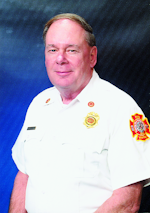
Robert Burke
Robert Burke, who is a hazardous materials and fire protection consultant and who served as a Firehouse contributing editor, is a Certified Fire Protection Specialist (CFSP), Fire Inspector II, Fire Inspector III, Fire Investigator and Hazardous Materials Specialist. He has served on state and county hazmat teams. Burke is the author of the textbooks "Hazardous Materials Chemistry for Emergency Responders," "Counter-Terrorism for Emergency Responders," "Fire Protection: Systems and Response," "Hazmat Teams Across America" and "Hazmatology: The Science of Hazardous Materials."
